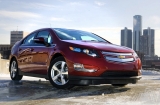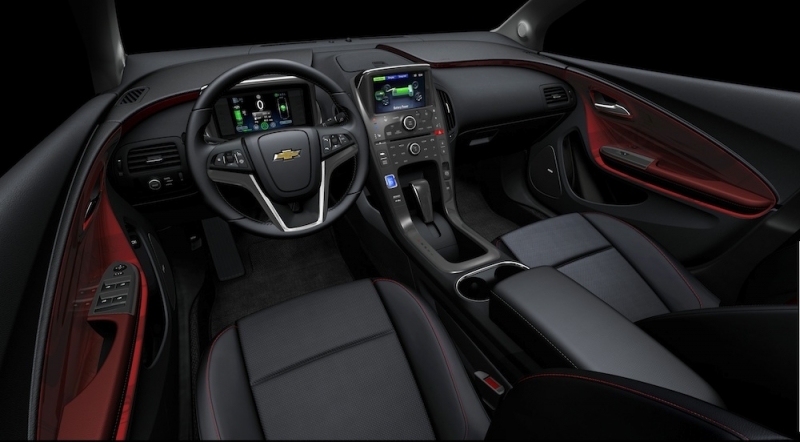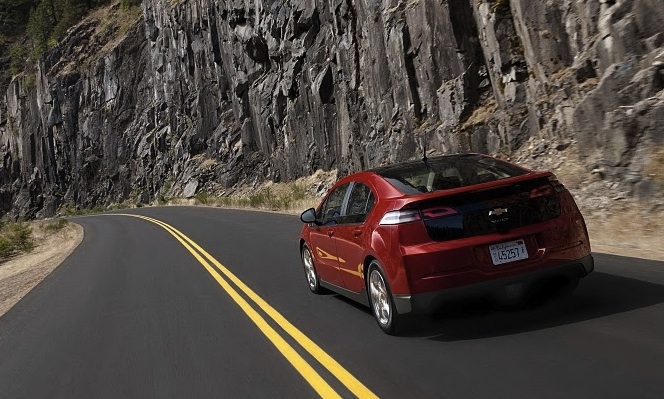Need Help?
2011 Chevrolet Volt Base 4dr Sedan
Trim Info:
Front wheel drive, 5 Door Sedan Hatchback
Other Trims
Do you own this car?
Estimated Mileage
Miles
Estimated Mileage
Miles
Enter current mileage for most
accurate info about this vehicle
accurate info about this vehicle
Track Your Service Records
Get Recall Alerts
Get Updated Value Estimates on Your Car.
Expert Reviews
May 4, 2019 by Alison Lakin
No car in the last decade has been talked about more than the 2011 Chevrolet Volt. Had the recession and subsequent bailout not occurred, the Volt might have ended up as a one-off, Chevrolet's attempt to throw its hat into the electric/alternative fuel ring. Instead, the first-ever production extended-range vehicle became their saving grace, and its success lies in its unique power range and impressive quality.
To lay any confusion to rest, the Volt is both an electric car and a hybrid. The former's power comes from a lithium-ion battery pack and electric motor combination that switches over to a hybrid mode when the charge has been depleted, after about 40 miles. The car then uses a small 1.4-liter engine to power the wheels, charging the battery when braking or coasting and using battery power when available. Charging is a simple affair, and on a standard outlet it will take about 10-12 hours, while a 240-volt outlet can fully charge the battery in about four hours.
The impact of the Volt’s greater importance has greatly overshadowed the actual car, which is surprisingly comfortable, good-looking and informative too, thanks in part to all the cool power usage and efficiency displays you can flick through on the standard touchscreen interface. Details (is it an electric car? a hybrid? what’s the actual mpg?) may have been haggled over for seemingly years now, so it’s easy to forget that the Volt is, at its core, simply a good vehicle.
What's to Like
Interior styling is high quality, and the futuristic, button-free instrument panel looks new without seeming too alien. The switch between electric mode and gas power is as seamless as we've ever experienced. The extended-range concept is the right one for America; you'll be able to run around town and commute without using a drop of gas, but you can hit the road for a family road trip, no problem.
Interior styling is high quality, and the futuristic, button-free instrument panel looks new without seeming too alien. The switch between electric mode and gas power is as seamless as we've ever experienced. The extended-range concept is the right one for America; you'll be able to run around town and commute without using a drop of gas, but you can hit the road for a family road trip, no problem.
What's Not to Like
The Volt's not cheap, even with the $7500 tax credit, and much like iPhone devotees, you'll pay a premium for being an early adopter. The estimated range of 25-50 miles per charge of pure electric power isn't much, especially considering the charging time. Having just four seats instead of five limits its functionality. The rear hatch cover is cheap. The small engine makes a lot of noise when it's revved.
The Volt's not cheap, even with the $7500 tax credit, and much like iPhone devotees, you'll pay a premium for being an early adopter. The estimated range of 25-50 miles per charge of pure electric power isn't much, especially considering the charging time. Having just four seats instead of five limits its functionality. The rear hatch cover is cheap. The small engine makes a lot of noise when it's revved.
Driving Impressions
Most people will be surprised to find that the Volt drives similarly to many cars on the road, except that when you start it up, it's completely silent. The car chimes to let you know it's on, and then you can glide off to your destination. Steering has an electric feel to it, but it's direct. Visibility can be an issue though, with the sloped rear hatch, there's a lot of sheet metal to look around. Many hybrids make it well known when the car switches power sources, but in the Volt it's hardly noticeable; only when you give it some gas does the engine's sound permeate the cabin – and that's a good thing considering its harsh engine note. The Volt uses regenerative brakes to return power to the battery while braking or coasting, so the brake pedal can go from mushy to firm without much warning, making it hard to regulate your stopping speed.
Most people will be surprised to find that the Volt drives similarly to many cars on the road, except that when you start it up, it's completely silent. The car chimes to let you know it's on, and then you can glide off to your destination. Steering has an electric feel to it, but it's direct. Visibility can be an issue though, with the sloped rear hatch, there's a lot of sheet metal to look around. Many hybrids make it well known when the car switches power sources, but in the Volt it's hardly noticeable; only when you give it some gas does the engine's sound permeate the cabin – and that's a good thing considering its harsh engine note. The Volt uses regenerative brakes to return power to the battery while braking or coasting, so the brake pedal can go from mushy to firm without much warning, making it hard to regulate your stopping speed.
Engine and Drivetrain
The electric portion of the drive uses a lithium-ion battery pack and two electric motors to power the front wheels. It uses that same setup when in hybrid mode at times, but the primary power source in this case comes from 1.4-liter inline-four engine. The engine alone produces 84 horsepower, while the electric motors produce a total of 149 horsepower.
The electric portion of the drive uses a lithium-ion battery pack and two electric motors to power the front wheels. It uses that same setup when in hybrid mode at times, but the primary power source in this case comes from 1.4-liter inline-four engine. The engine alone produces 84 horsepower, while the electric motors produce a total of 149 horsepower.
Green Evaluation/Gas Mileage
When the gas engine is on, the Volt returns 90-95 mpg – the EPA’s electric car mpg estimate. With the gas engine, you’ll see 35 mpg city and 40 mpg highway. But technically, you could forego miles per gallon almost entirely if the Volt is charged regularly and doesn't ever switch over to engine power. Having to fill it with premium fuel is extra incentive to use electricity when possible. On average, you can drive an estimated total 379 miles per full charge/tank.
When the gas engine is on, the Volt returns 90-95 mpg – the EPA’s electric car mpg estimate. With the gas engine, you’ll see 35 mpg city and 40 mpg highway. But technically, you could forego miles per gallon almost entirely if the Volt is charged regularly and doesn't ever switch over to engine power. Having to fill it with premium fuel is extra incentive to use electricity when possible. On average, you can drive an estimated total 379 miles per full charge/tank.
Vehicle Details
Interesting Features and Technology
On the LCD dash is an efficiency meter that takes a similar form to that of a level. The goal is to keep a ball centered within the meter by using slow acceleration and braking to maximize the regenerative brakes.
On the LCD dash is an efficiency meter that takes a similar form to that of a level. The goal is to keep a ball centered within the meter by using slow acceleration and braking to maximize the regenerative brakes.
Included as standard are plenty of tech features worthy of the technology under the hood, such as a six-speaker Bose sound system, Bluetooth hands-free connectivity and a USB port to connect your audio player. The large central screen also houses a standard navigation system, though the rearview camera and park assist system is only available as an option. It’s worth having though, since there’s limited visibility out of the rear.
Interior
With its high belt line, the Volt's cabin becomes more like a cockpit. The white instrument panel is the star of the show and the flat plane uses touch-sensitive areas instead of buttons. It sounds complicated, but the layout is intuitive, especially when combined with the touch screen.
With its high belt line, the Volt's cabin becomes more like a cockpit. The white instrument panel is the star of the show and the flat plane uses touch-sensitive areas instead of buttons. It sounds complicated, but the layout is intuitive, especially when combined with the touch screen.
Exterior
Chevrolet chose an aerodynamic shape similar to that of the Prius to boost efficiency, and the five-door hatchback styling looks modern without pushing the envelope. There's no mistaking it for anything else but the Volt, however, and the end result looks very much like a Chevy, Bowtie-adorned grille and all.
Chevrolet chose an aerodynamic shape similar to that of the Prius to boost efficiency, and the five-door hatchback styling looks modern without pushing the envelope. There's no mistaking it for anything else but the Volt, however, and the end result looks very much like a Chevy, Bowtie-adorned grille and all.
Market Segment and Pricing
No other extended-range vehicle has been produced to rival the Volt, but you can be sure one won't be far behind. The $40,280 Volt (don’t forget to subtract the $7500 tax credit!) does have plenty of competition from other alternative fuel vehicles, including the Toyota Prius, Volkswagen Jetta TDI, Nissan Leaf and the upcoming Toyota Prius plug-in. Pricing for those is all over the map, but only a handful of cars on the market get a full tax credit like the Volt does.
No other extended-range vehicle has been produced to rival the Volt, but you can be sure one won't be far behind. The $40,280 Volt (don’t forget to subtract the $7500 tax credit!) does have plenty of competition from other alternative fuel vehicles, including the Toyota Prius, Volkswagen Jetta TDI, Nissan Leaf and the upcoming Toyota Prius plug-in. Pricing for those is all over the map, but only a handful of cars on the market get a full tax credit like the Volt does.
What We Think
Our range anxiety, however silly of a term, is a real limitation for automakers exploring electric vehicles. With electric-only vehicles, it’s easy to worry about running out of power on the road without the ability to charge the car. The Chevrolet Volt successfully bridges the gap between gas and electric power to keep worries at bay. It also happens to have a well-designed interior and a subtly special overall look. Everything about it is oddly familiar, making the transition from gas-powered cars to the future all the easier.
Our range anxiety, however silly of a term, is a real limitation for automakers exploring electric vehicles. With electric-only vehicles, it’s easy to worry about running out of power on the road without the ability to charge the car. The Chevrolet Volt successfully bridges the gap between gas and electric power to keep worries at bay. It also happens to have a well-designed interior and a subtly special overall look. Everything about it is oddly familiar, making the transition from gas-powered cars to the future all the easier.
|
|
Similar Articles
Your Local Mechanics












